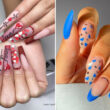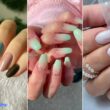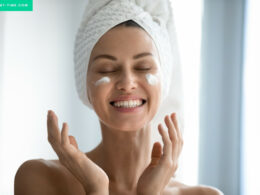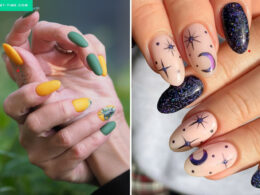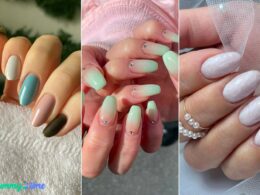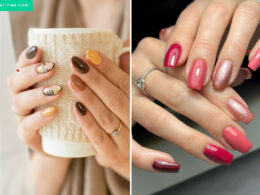In This Article Show
As a mum of three, I’ve learned that our beauty regimen can sometimes feel like one more task on an endless to-do list. Yet, we must take those precious moments for ourselves, not just for the sake of appearance but for our well-being too.
Over time, I’ve picked up on a few common beauty mistakes that many of us don’t even realize we’re making. These slip-ups can range from the skincare products we use to the makeup application techniques we employ, and they can have a sneaky way of undermining our efforts to look and feel our best.
Maintaining a beauty routine while managing a bustling household means it needs to be effective, straightforward, and forgiving of the occasional shortcuts. In the spirit of keeping things simple, I’m here to share insights on these easy-to-overlook beauty blunders.
Mistake #1: Over-Exfoliating Your Skin
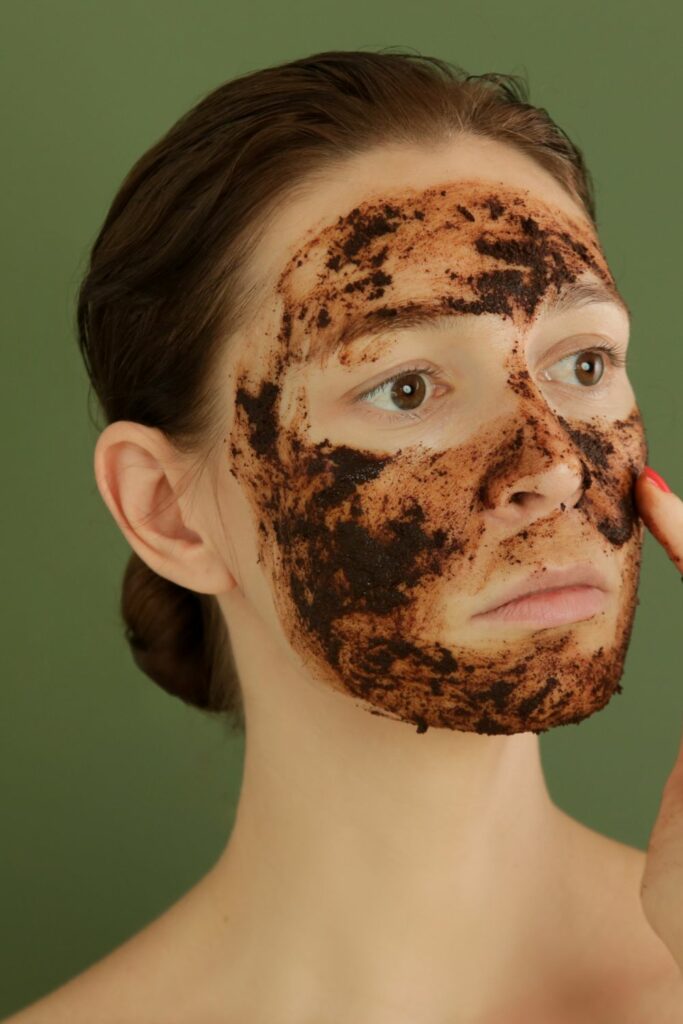
When it comes to keeping our skin fresh and radiant, exfoliation is a step many of us swear by. It’s the process of sloughing off dead skin cells to reveal the newer, brighter skin underneath.
However, in our quest for a youthful glow, there’s a fine line between thorough exfoliation and going overboard, and crossing it can do more harm than good.
Signs of Over-Exfoliation
Recognizing the symptoms of over-exfoliated skin is key. If you notice increased sensitivity, redness, a feeling of tightness, or skin that seems shiny but not in a healthy way, it’s time to ease up on the scrubbing. Another red flag is if your skin stings or burns when applying products that were previously well-tolerated.
Great deals to snatch for your little ones 🎉
How Often You Should Exfoliate
The rule of thumb for exfoliation is moderation. Generally, exfoliating 1-2 times a week is sufficient for most skin types. If you have particularly sensitive or dry skin, you may want to limit it to once a week or even less.
And if you’re using chemical exfoliants, which can be more potent than physical ones, paying attention to how your skin responds is critical to avoiding over-exfoliation.
Mistake #2: Ignoring the Neck and Décolletage
Now, let’s talk about a commonly neglected part of our beauty routine: the care for our neck and décolletage. It’s easy to forget that the skin doesn’t stop at the jawline, but these areas can be telltale signs of aging and skin damage if not looked after with the same diligence as our faces.
Tips for Including These Areas in Your Beauty Routine
Incorporating neck and décolletage care into your beauty routine doesn’t have to be a hassle. Here’s how you can do it efficiently:
1. Extend Everything Downward
When applying your cleanser, moisturizer, serum, or sunscreen, don’t stop at your chin. Extend the application in gentle, downward strokes all the way to the chest area.
2. Specialized Products
If you’re dealing with specific issues like hyperpigmentation or loss of firmness in these areas, look for products targeted for the neck and décolletage. These can be particularly formulated with ingredients to tackle these concerns.
3. Sun Protection Is Key
The neck and décolletage are as susceptible to sun damage as your face, if not more. Ensure you apply a broad-spectrum SPF daily to these areas.
4. Gentle Exfoliation
Just like your face, the neck and décolletage benefit from exfoliation to remove dead skin cells. However, remember to exfoliate gently to avoid irritation.
Mistake #3: Using Dirty Makeup Brushes
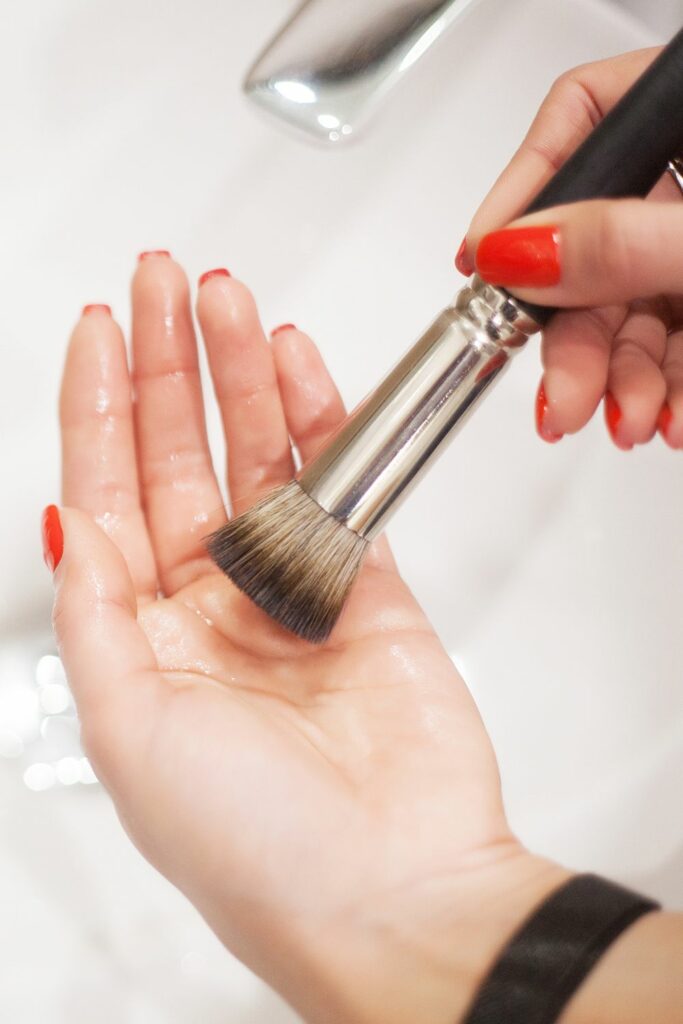
If you’ve ever rushed through your makeup routine, chances are you’ve overlooked the importance of using clean brushes. It might seem inconsequential, but the truth is, that the cleanliness of your makeup tools is as important as the makeup itself for a flawless beauty regimen.
Tips on Cleaning and Maintaining Your Brushes
Keeping your brushes in pristine condition doesn’t have to be a chore. Here are some tips to ensure your brushes stay clean and your skin stays happy:
1. Regular Washing
Make a habit of cleaning your brushes thoroughly once a week. For brushes used with liquid or cream products, consider washing them after each use to prevent product buildup.
2. Proper Technique
Swirl the brush bristles in the palm of your hand with soap and lukewarm water. Then, rinse until the water runs clear, taking care not to submerge the brush base to avoid loosening the glue over time.
3. Drying Correctly
After washing, reshape the brush head and lay the brushes flat to dry. Avoid drying them upright which can allow water to seep into the handle, again, this can loosen the glue and lead to bristle loss.
Mistake #4: Skipping Sunscreen Indoors
It’s a common misconception that if we’re not basking in the great outdoors, we can skip the sunscreen. However, the truth is that the sun’s UV rays can reach us indoors, too, and that’s not the only skin-damaging light we’re exposed to inside our homes or offices.
Sun protection isn’t just for sunny days at the beach. Ultraviolet A (UVA) rays, known for their role in skin aging and wrinkling, can penetrate window glass, meaning your skin can be exposed while driving, working near a window, or just lounging in a sunlit room.
How to Mitigate The Effect
1. Use Broad-Spectrum Sunscreen
A broad-spectrum sunscreen can protect your skin from both UVA and UVB rays. Apply it as part of your morning routine, regardless of whether you plan to spend the day inside or out.
2. Reapply Sunscreen
If you’re near windows or outside for extended periods, reapply sunscreen every two hours just as you would if you were outdoors.
3. Consider Blue Light Protection
Some sunscreens and skincare products now include ingredients that claim to protect against blue light. Ingredients like iron oxides and antioxidants may help combat the potential effects of blue light on the skin.
Mistake #5: Incorrect Order of Skincare Application

Skincare is an investment in your skin’s future, but if you’re not layering your products correctly, you might not be getting the full benefits. The order in which you apply your skincare products matters just as much as the products themselves.
A Quick Guide to the Correct Sequence of Application
Here’s a basic guideline you can follow to stack your skincare products properly:
- Cleanser: Start with a clean canvas by using a gentle cleanser to remove impurities and excess oils.
- Toner: If you use a toner, apply it after cleansing as it helps to remove any leftover impurities and preps the skin for better absorption of subsequent products.
- Serum: Serums, which are usually packed with concentrated active ingredients, should be applied post-toning.
- Eye Cream: Apply eye cream before your moisturizer so its delicate ingredients can absorb without any barriers.
- Spot Treatment: If you have acne or other targeted treatments, apply them before heavier creams so they can directly treat the problem area.
- Moisturizer: Apply a moisturizer to hydrate and lock in all the goodness of the previous layers.
- Face Oil: If you use a face oil, it goes on after moisturizer. Oils can penetrate moisturizers, but not vice versa.
- Sunscreen: Finally, sunscreen should be the last step in your daytime skincare routine. This ensures that you have maximum protection without diluting the sunscreen’s effectiveness.
Mistake #6: Not Patch-Testing New Products
As a beauty enthusiast, the excitement of trying a new skincare product can sometimes overshadow the necessary precautionary steps. Patch-testing often falls by the wayside, but this simple act can save your skin from potential irritation, allergic reactions, or worse.
How to Properly Perform a Patch Test
To ensure the safety and suitability of a new product, here’s how to conduct a proper patch test:
1. Choose the Right Spot
The inside of your wrist or the side of your neck is often recommended for patch tests because the skin is thinner and more reactive, which makes it easier to spot any reactions.
2. Apply a Small Amount
Use a small amount of the product on clean skin in the chosen area. If it’s a wash-off product, follow the instructions accordingly, but leave it on for the full duration you would normally use it on your face.
3. Wait and Observe
After applying the product, wait for at least 24 hours. Observe the area for any signs of a reaction, such as redness, bumps, itchiness, or burning. If you’re testing for a delayed reaction, it’s a good idea to wait up to 72 hours.
Mistake #7: Overusing Heat Styling Tools
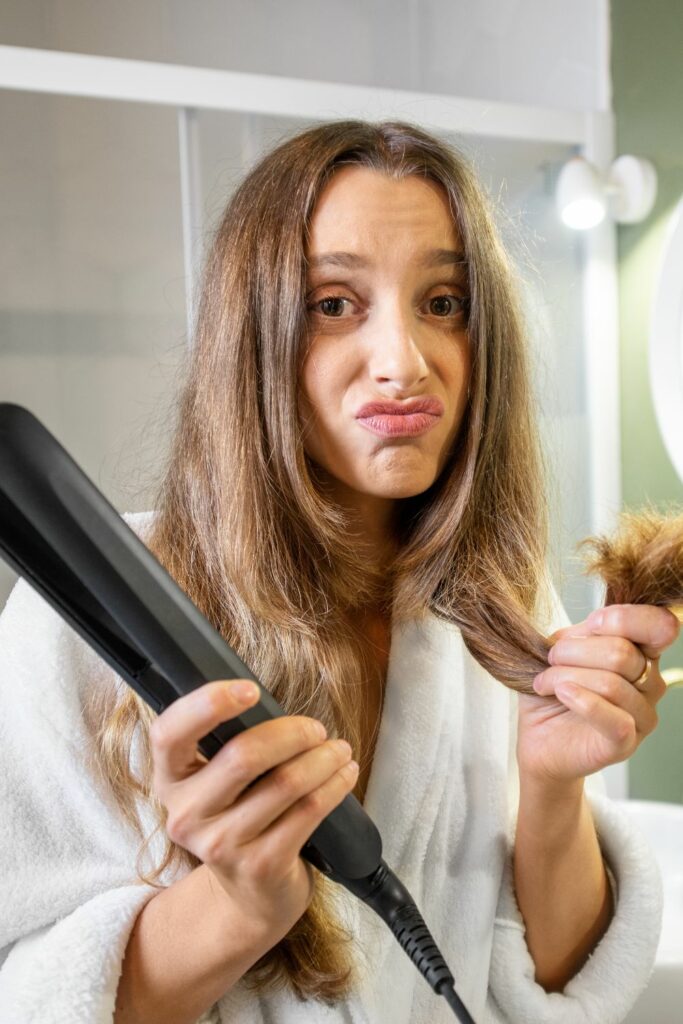
Heat styling tools like flat irons, curling wands, and blow dryers have become indispensable in many beauty routines for achieving polished looks. However, their frequent use can affect your hair’s health.
Tips for Minimizing Damage and Alternative Styling Methods
Here’s how you can minimize damage from heat styling and explore other ways to style your hair:
1. Use Heat Protectant
Always apply a heat protectant spray or serum before using any heat-styling tools. These products form a protective barrier over the hair shaft to reduce moisture loss and thermal damage.
2. Reduce Frequency
Try to limit the use of heat-styling tools. Giving your hair a break allows it to recuperate and maintain its health.
3. Embrace Natural Textures
Explore hairstyles that work with your hair’s natural texture. This can be as simple as air-drying your hair or using techniques like braiding or twisting to shape your hair as it dries.
4. Heat-Free Styling Alternatives
Use rollers, flexi-rods, or wrapping techniques for curls and waves without heat. For straightening, hair wrapping or wet sets can be effective.
5. Regular Trims
Keeping your hair trimmed regularly helps prevent split ends from working their way up the hair shaft, which can be exacerbated by heat styling.
8. Deep Conditioning
Integrate deep conditioning treatments into your routine to replenish moisture and nutrients in your heat-styled hair.
Mistake #8: Sleeping with Makeup On
After a long day, it might be tempting to skip your nighttime skincare routine and head straight to bed. However, sleeping with your makeup on can lead to several skin issues that can easily be avoided with a proper cleansing routine.
The Skin Damage That Can Occur Overnight
When makeup is left on overnight, it can mix with the dirt and oils that have built up on your skin throughout the day, leading to clogged pores and breakouts.
Furthermore, makeup can trap free radicals that your skin is exposed to during the day, leading to the breakdown of healthy collagen, and resulting in premature aging, dullness, and texture changes. Eye makeup left on overnight can lead to eye irritation, infections, or even styes.
Mistake #9: Neglecting the Lips
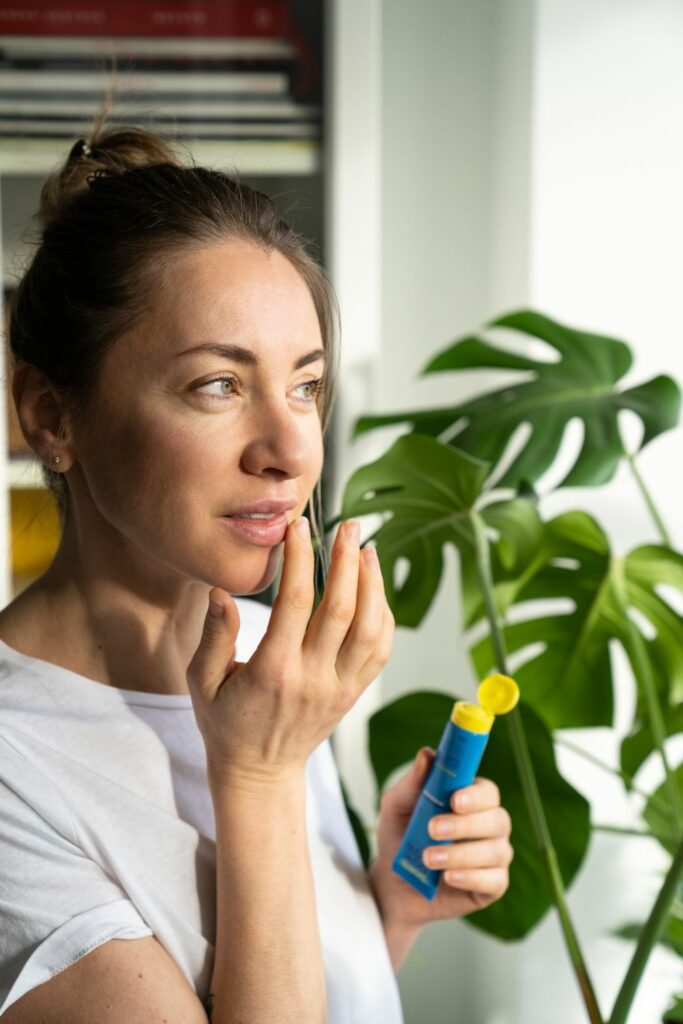
Lips are often an afterthought in many beauty routines, but they shouldn’t be. The skin on your lips is thinner and more delicate than the rest of your face, which makes it more susceptible to dryness, cracking, and aging. Incorporating lip care into your daily regimen is essential for maintaining healthy, supple lips.
Importance of Lip Care in the Beauty Routine
Proper lip care is crucial because:
- Hydration: Lips lack oil glands, so they don’t produce natural oils like the rest of the skin does, which means they can become dehydrated and chapped more easily.
- Sun Protection: Lips are susceptible to sunburn since they don’t have melanin.
- Smooth Base: Well-cared-for lips provide a smooth canvas for lipstick or gloss.
- Aging Prevention: The lips can show signs of aging just as the rest of the face does, but with proper care, you can help keep them looking youthful.
Recommendations for Lip Care Products
To keep your lips in top condition, consider the following product recommendations:
- Lip Balm with SPF
- Hydrating Lip Masks
- Exfoliating Lip Scrubs:
- Nourishing Lip Oils
- Lip Serums
- Tinted Lip Balms
Mistake #10: Using Expired Products
In the realm of beauty and skincare, using products past their expiration date is a commonly overlooked mistake. While it may seem harmless to use up that nearly-empty foundation or cherished lipstick, expired products can harbor bacteria and lose their efficacy, leading to potential skin irritations or infections.
Risks Associated with Using Expired Beauty Products
Here are some risks of using outdated beauty items:
- Infection: Expired products can become a breeding ground for bacteria and fungi, increasing the risk of infections, especially in products used near the eyes or on broken skin.
- Irritation: Ingredients can break down over time and potentially cause irritation or allergic reactions.
- Reduced Performance: Expired makeup may not apply as well, and skincare products may not perform as intended, rendering them ineffective.
- Chemical Changes: Certain ingredients may degrade into harmful substances that could cause skin issues or health concerns.
Mistake #11: Not Drinking Enough Water
Hydration is the cornerstone of not just overall health, but also of a radiant complexion. Water consumption can often be overlooked in a beauty routine, but it’s essential for maintaining optimal skin health and vitality.
Tips for Incorporating More Water into Your Daily Routine
For those who struggle to consume adequate amounts of water, here are some practical ways to increase hydration:
- Start Your Day with Water: Make it a habit to drink a glass of water every morning when you wake up to kickstart your hydration.
- Infuse Flavor: If you find plain water unappealing, try adding a slice of lemon, cucumber, or a handful of berries to infuse your water with a refreshing taste.
- Eat Water-Rich Foods: Incorporate fruits and vegetables with high water content, like cucumbers, tomatoes, oranges, and watermelons, into your meals.
- Hydrate Before Meals: Drinking a glass of water before each meal not only contributes to your daily intake but can also aid digestion and prevent overeating.
- Replace Other Drinks: Opt for water instead of sugary drinks or alcohol, which can dehydrate your skin.
Drinking enough water is a simple yet effective habit that supports skin health and enhances your beauty routine. By making water consumption a priority, you’re investing in both your internal well-being and external appearance, leading to skin that’s hydrated, happy, and glowing.
Mistake #12: Matching Foundation to the Wrong Part of Your Body
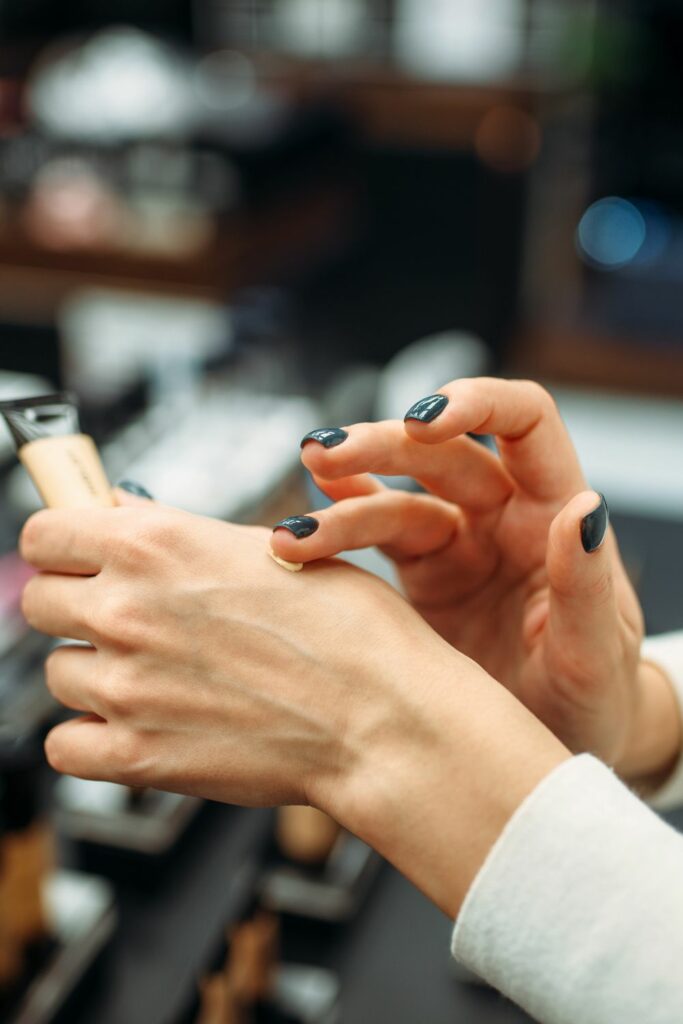
Choosing the right foundation shade is pivotal for a seamless and natural makeup look. A common error is testing foundation shades on the back of the hand or wrist, which can lead to a mismatch because these areas may have a different tone compared to your face.
The Impact of Incorrect Foundation Color on Your Overall Look
Wearing the wrong foundation shade can have several unintended effects on your appearance:
- Unnatural Contrast: If the foundation is too light, it can make you look ashy or washed out. If it’s too dark, it can appear as if you’re wearing a mask.
- Highlighting Skin Issues: The wrong shade can draw attention to imperfections rather than concealing them.
- Affects Makeup Harmony: The rest of your makeup may not blend as seamlessly if the base is off, which can throw off the balance and harmony of your overall look.
Finding the perfect foundation shade might take some effort, but it’s worth it for the confidence that comes with a flawless complexion. It’s the canvas for all your other makeup, so ensuring it matches perfectly is essential for a cohesive and polished appearance.


